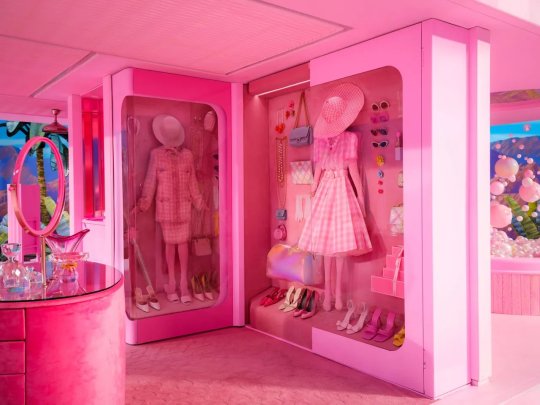#BARBIE PRODUCTION DESIGN TEAM YOU WILL ALWAYS BE FAMOUS
Explore tagged Tumblr posts
Text





#her wardrobe/closet looking like barbie clothing packaging from the 80s...#BARBIE PRODUCTION DESIGN TEAM YOU WILL ALWAYS BE FAMOUS#ref#barbie#film
9K notes
·
View notes
Text
Looking Back on the History of the Most Famous Toy Cars in the World » AutoGuide.com News
http://www.autositenews.com/?p=7590
Are you ready to feel old? Those diecast cars you’ve got kicking around in desk drawers, displayed in a place of honor in your garage, or that you step on after your kids left them out on the carpet are now officially middle-aged. Now that Hot Wheels are turning 50, it has proved how much staying power there is in tapping into the imaginations of children and adults alike with both realistic and rip-snorting metal-and-plastic dream vehicles whose shapes are limited only by the fevered grey matter of Mattel’s designers.
Check out these key moments from Hot Wheels’ first 50 years.
Picture Frames to Doll Houses to…World Domination?
It’s rare that a company gets to come up with an idea that revolutionizes an entire industry, but Mattel, the company behind Hot Wheels, managed to do it not once, but twice. Originally formed in 1945 by Harold Matson, Elliot Handler, and Ruth Handler (wife of Elliot), Mattel initially focused on picture frames, of all things, but quickly branched out into building doll houses with all of the spare materials they had lying around.
Finding a welcome home in the growing toy niche, Mattel trundled forward for 15 years tackling a variety of toys before Ruth hit upon the Barbie bonanza. As if launching a franchise that would sell more than a billion dolls wasn’t enough, nearly decade later Elliot would introduce 4-billion-sold Hot Wheels line of diecast cars, creating the one-two punch that would ensure essentially eternal cash flow for the once-modest company.
Different Than The Rest – By Design
Elliot Handler didn’t invent the concept of selling diecast cars to kids, as companies like Matchbox and Korgi had already had substantial success in that area. What Handler did differently was to shy away from exclusively producing realistic replicas of road-going vehicles and instead focus on exotic hot rods and interesting custom cars created by a rotating stable of designers. Elliot’s logic was that if he could tap into a child’s imagination, he could get them more interested in something that looked like a rolling shark instead of a school bus.
ALSO SEE: This is the Most Epic Hot Wheels Video You’ve Ever Seen
He was right, and it certainly didn’t hurt that he engaged some of the most creative minds in the car business – miniature or otherwise. From early designers like Larry Wood, Ira Gilford, and Harry Bentley Bradley to current team members like Bryan Benedict, a significant percentage of the Hot Wheels brain trust hailed (and continue to hail) from the full-size auto industry.
The Science Of Play
Hot Wheels had another advantage over Matchbox et al, and that was the level of attention paid to how they were engineered. Although much of today’s HW talk centers around collectors, back in the ’60s and ’70s, Handler wanted to make sure that kids actually played with the cars after their crazy cool designs had convinced them to take them home.
He knew that toys that were played with stuck better in the minds of the young than those that just sat on a shelf, and so he hired people like Jack Ryan, a former Raytheon employee, to initially come up with low-friction wheel bearings (made of a material called Delrin), thin axles, and plastic or rubber tires that would let Hot Wheels cars glide significantly farther and much, much faster than their Matchbox rivals (which used a nail axle that was too thick to spin quickly, connected to heavy metal wheels). He also made sure that his toys were a perfect fit for the tracks and playsets that Mattel sold alongside the cars.
It was an onslaught that caught Matchbox completely off-guard and forced then-parent company Lesney to come out with their own, more play-oriented models called ‘Superfast’ a few years later. Some of these early Superfast models had unusual wheel proportions as Lesney was unable to quickly change its castings. Eventually, the entire industry, including Corgi and Majorette, would make the swap to the Hot Wheels fast-axle design style.
Blistering Up
Another revolution brought on by Hot Wheels had to do with how the cars were marketed in stores. In 1968, very few diecast companies were using blister packs, preferring instead to hide their cars inside small boxes (indeed, the genesis of the entire Matchbox brand name) and rely on art to represent the vehicle. Hot Wheels went fully in the other direction, prominently displaying not just the vehicle itself encased in its plastic bubble, but going whole-hog in using the HWs logo, bright colors, bonus pieces and parts, and fantastic, exciting art on both sides of the card to highlight their models.
The man to thank for this strategy was Otto Kuhni, a long-time Mattel hand who spent more than 30 years working in the toy business. Again, this plan of retail attack was soon copied by the competition, indicating just how groundbreaking Hot Wheels was as a market force when it first arrived on the scene.
’70s Bring Changes, ’80s Brings Stability
With the rest of the industry scrambling to catch up, Hot Wheels used the ’70s to experiment with wheel and paint options in a bid to balance costs and style. Until 1977, Mattel built ‘Redline’ wheels which had a thin red line painted around the outside edge. Highly desirable today, these models were phased out once the muscle car craze had died down. Mattel also retired its ‘Spectraflame’ paint schemes in the middle of the decade in order to embrace more affordable, and realistic paint colors. The addition of decals and prints on vehicles in 1974, however, would set the tone for the brand heading into the next decade, and for a third time causing rival toy companies to get more creative with their own diecast presentation.
ALSO SEE: Is This Guy’s $1-Million Hot Wheels Collection Crazy or Crazy Cool?
By the time the ’80s rolled around, Hot Wheels was starting to add more ‘everyday’ cars to its fleet, broadening its appeal to include buyers less interested in hot rods. Axles got even thinner, making vehicles faster, and real rubber tires on the ‘Real Riders’ line of cars additionally made their debut, a feature that would be available on and off for Mattel’s foreseeable future. Also important: the blue-backed card on the blister packs which made it onto shelves at the end of the decade, and then never left.
Corvette Chaos
Mattel has always had a close relationship with most automakers, but things got a little too intimate for Chevrolet’s comfort in 1983 when the brand released a diecast of the upcoming C4 generation Corvette before that vehicle had actually gone on sale. Production woes had delayed the C4’s on-sale date to the 1984 model year, but Hot Wheels had already seen a prototype of the vehicle in 1982 and went ahead with their 1:64 edition of the vehicle before the car had been finalized. The end result was a Hot Wheels ‘Vette that wasn’t quite true to the actual C4 spec, but still close enough to generate significant heat towards the brand at GM headquarters. Only 43 actual Corvettes were built for the non-existent 1983 model year, and only one survives to this day.
Spinning Off The Series
By the time the ’90s rolled around, Mattel saw significant value in starting to service the collectors that were driving up prices on their older castings. This is when Model Series, First Editions, Treasure Hunt limited editions, and collector numbers on blister packs started to appear. Things branched out even further in the 2000s, what with Segment Series, Formula 1, anniversary editions, and subsets like Tooned, Blings, Track Aces, Mystery Cars, and All Stars each making an appearance. Further tie-ins with movie productions, special events like SEMA, brands like Little Debbie, Major League Baseball, as many retailers as you could possibly imagine, and of course the racing world further legitimized Hot Wheels’ place as a pop culture icon.
Buying Out the Competition
Is there a sweeter sensation in the business world than purchasing the assets of your biggest rival? Mattel did exactly that when it acquired Tyco Toys Inc., in 1997, and along with it, the Matchbox brand. Sure, it only cost $700-million or so, but how can you put a price on total diecast dominance? For the most part, Mattel continued to operate Matchbox along its traditional “real world cars only” lines, but there have been a number of fantasy-type vehicles that have slipped into the mix in the decades since the purchase. Matchbox itself turned 50 all the way back in 2002, which was right around the time Mattel decided to start more aggressively expanding its offerings beyond what came in the once-yellow box.
Named After an El Camino?
Finally, you’ve probably wondered your entire life how Elliot Handler came up with the Hot Wheels name. Would it surprise you to learn that there’s no consensus of what, exactly, inspired a brand name so famous it became synonymous with 1:64 cars?
Some brand lore ties it to a casual conversation about the wheels on Harry Bradley’s Chevrolet El Camino. Apparently, Handler was walking by the car in the corporate parking lot one day and happened to tell Bradley, “Hey, those are some hot wheels.”
An alternate version of this story has Elliot talking about a prototype car being driven by vehicle designer Fred Adickes. Handler has also said that Mattel employee Alexandra Laird had suggested the term “Big Wheels,” which got him thinking down the track the led to Hot Wheels instead.
We’ll let you choose your own adventure on which story you decide to believe. And now, if you’ll please excuse us, we’ve got some tracks to build and cars to crash.
Source link
0 notes
Text
5 Steps to Build Your Global Ecommerce Site
Learn cultural norms and shopping habits to create an e-retail experience that feels familiar to your international audience.
Is your company ready to go global with ecommerce? Maybe it should be. Opportunities to sell globally are substantial and growing. While ecommerce retail sales in the United States are rising — expected to reach $523 billion in the next five years — that number is growing even more rapidly worldwide.
Globally, business-to-consumer (B2C) online sales is on pace to exceed $2 trillion by 2017. E-sales in Asia Pacific will surpass those in North America during that same year. The increased use of mobile devices in those regions, plus better payment systems and advanced shipping methods, are contributing to this trend. Consumers in many overseas markets can’t get the products they want in local markets. This presents a huge opportunity for U.S. retailers.
But launching overseas isn’t easy. If you think you’re ready to expand your online retail footprint across borders, you need to consider some important factors.
1. Assess supply and demand.
To get a clearer picture of your probability for success in other markets, first assess your business from the local point of view in your product’s new space. Conduct a regional analysis around local competitors, product demand, pricing and consumer behavior.
According to ecommerce provider Pitney Bowes, organizations “need to make sure they have a full understanding of what they’re selling today and the current demand” in international markets. This knowledge will help you home in on the size of the market that exists, the supply-and-demand dynamic for your product and the price at which it can be sold.
For example, McKinsey found that most online spending in China can be attributed to just a handful of online retail segments: apparel, recreation, education and household products. This presents an undeniable opportunity within these markets. Similarly, another study discovered that Australia is one of the strongest markets for U.S.-based online retail. The duty threshold and minimal local supply allow goods to move across borders at an affordable cost. These early learnings either enable ecommerce operations to succeed abroad or doom them to fail in far-flung places.
2. Localize your product.
Businesses that launch physical products in international markets usually need to augment or adapt their solutions to support local preferences. Many U.S.-based businesses have failed to bring existing products to new markets because company leaders think that aggressive marketing or pricing can change entrenched cultural appetites.
One of the most famous examples is Mattel, the toy powerhouse. It failed to launch Barbie in China several years ago due to just such a disconnect. According to reports, Barbie’s look wasn’t attractive to Chinese women. Mattel disregarded local consumer tastes, including the “cutesy … pink clothes” aesthetic popularized by Hello Kitty. The “sexy” Western Barbie was simply off-putting. Mattel poured resources into the market, and Barbie has since rebounded in China. However, this type of mistake would be insurmountable for smaller companies.
Related: Nutella Burgers and Other Crazy Fast Food Items From Around the World
3. Localize your site.
Authentic localization is a crucial driver for regionalized sales. Your ecommerce site experience should reflect the time and care you spent customizing the product itself. Consumers won’t make a purchase if they don’t understand your product or can’t tune in to your message. In fact, 87 percent of consumers who can’t read English won’t purchase products or services from an English-language website, while 60 percent of global customers rarely buy on English-language sites.
Believe it or not, some companies rely on Google translate to approximate different languages when expanding internationally. According to Russell Goldsmith, Director at U.K. translation company Conversis, this type of website shortcut is a mistake.
“If you care about your audience in that local territory, you could end up making things worse for yourself because anyone who speaks that language will see that it’s been automated, and that it’s not perfect for their language,” Goldsmith says.
Recruit a local team to help your ecommerce experience adapt to a new market. Make certain your message translates to appeal to consumers in terms of language, style, tone, shopping habits and terminology. It’s also a good idea to include a glossary of terms for translators to keep your brand’s messaging intact.
4. Set prices accordingly.
When you enter a new market, you must price based on local currency. But price points that work in the United States don’t always work elsewhere. Competitive pricing is important in any market — and it’s determined by the local environment. More than half of consumers give more attention to an ecommerce site that has goods at local prices.
Many factors contribute to local pricing in global markets. These include:
Cost to manufacture the product
Fluctuations in foreign currencies
Price an international customer will pay
Your competitors’ pricing
Local regulatory or tax environment
It’s also important to support each region’s preferred payment method. While it’s exhausting to track so many purchasing habits, it can positively affect how your product sells. According to Ontraport, 50 percent of Germans prefer paying with bank transfers, while many Chinese customers favor the international payment platform Alipay.
If a customer tries to buy an international product and doesn’t see a preferred payment option, she or he probably will leave your site and look elsewhere. Offering a wide range of payment tools increases your product’s global reach.
Related: A Guide to International Payment Preferences
5. Focus on privacy and customer data.
If you’re building a global ecommerce site, you must understand how privacy and customer data pertains to overseas consumers. Customers want to know their privacy is being protected. They need reassurance their personal information won’t be used for unrelated business without their consent.
Cyber safety is a huge problem plaguing modern ecommerce. According to a Norton study, 40 percent of mobile shoppers in the Middle East and North Africa have been victims of cyber crimes. And 71 percent reported observing digital attacks in their region. Alternatively, European consumers are notoriously protective about their privacy online.
Put privacy front-and-center in messaging across your site experience to allay these fears. And back up those words by investing in the technology to keep customers’ private information, private. You’ll want a team in place to manage compliance and other security and privacy-related costs. An EU study points out two of the biggest challenges in cross-border trade: (1) the expenses synonymous with consumer-protection rules and contract law and (2) the costs of fraud and non-payment.
Related: Brexit Is Complicating Digital Marketing and EU Data Privacy
Expanding into the global ecommerce arena can be a challenging yet profitable new step for established and emerging brands alike. Keep the right priorities in mind to minimize the bumps, and you’ll accelerate your success in a new corner of the international online marketplace.
Resource: https://goo.gl/Ud94Cr
Web Design & Development Dubai E commerce web development Web design agency Dubai Web development Company Dubai Web developer Dubai
from WordPress http://ift.tt/2nxjl01 via IFTTT
0 notes